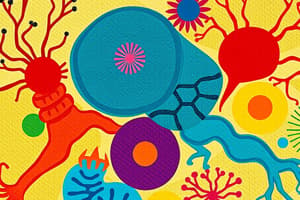Podcast
Questions and Answers
What are the 4 Eukaryotic Kingdoms? (Select all that apply)
What are the 4 Eukaryotic Kingdoms? (Select all that apply)
- Plants (correct)
- Protists (correct)
- Animals (correct)
- Fungi (correct)
Protists are what type of celled eukaryotes?
Protists are what type of celled eukaryotes?
Single
Protists are a very what group?
Protists are a very what group?
Diverse
Protists can be either heterotrophs or what?
Protists can be either heterotrophs or what?
Fungi are what type of celled eukaryotes?
Fungi are what type of celled eukaryotes?
Fungi have a cell wall usually made of what?
Fungi have a cell wall usually made of what?
Fungi are what type of organisms?
Fungi are what type of organisms?
Fungi grow through food and then what?
Fungi grow through food and then what?
What do heterotrophs do?
What do heterotrophs do?
Animals are what type of celled eukaryotes?
Animals are what type of celled eukaryotes?
Animals have no what?
Animals have no what?
Animals are what type of organisms?
Animals are what type of organisms?
Plants are what type of celled eukaryotes?
Plants are what type of celled eukaryotes?
Plants have a cell wall made of what?
Plants have a cell wall made of what?
Plants are what type of organisms?
Plants are what type of organisms?
What do autotrophs do?
What do autotrophs do?
Animals and fungi are closely what?
Animals and fungi are closely what?
Flashcards are hidden until you start studying
Study Notes
Eukaryotic Kingdoms
- Four main eukaryotic kingdoms: Animals, Plants, Fungi, and Protists.
Protists
- Protists are unicellular eukaryotes.
- They exhibit significant diversity among species.
- Can be heterotrophic (consuming other organisms) or autotrophic (producing their own food).
Fungi
- Fungi can be unicellular or multicellular eukaryotes.
- Their cell walls are primarily composed of chitin.
- All fungi are heterotrophs, absorbing nutrients through decomposition.
- Fungi grow by digesting food externally before consumption.
Animals
- Animals are exclusively multicellular eukaryotes.
- They lack a cell wall, allowing a range of complex structures and functions.
- Animals are heterotrophic, obtaining energy by consuming other organisms.
Plants
- Plants are also multicellular eukaryotes.
- Their cell walls are made from cellulose, providing structure and rigidity.
- Plants are autotrophs, capable of photosynthesis to create their own food using sunlight.
Nutritional Categories
- Heterotrophs: Organisms that obtain food by consuming others (animals and fungi).
- Autotrophs: Organisms that produce their own food (primarily plants).
Relationship Between Groups
- Animals and fungi share a close evolutionary relationship, indicating similarities in their biological processes and structures.
Studying That Suits You
Use AI to generate personalized quizzes and flashcards to suit your learning preferences.




